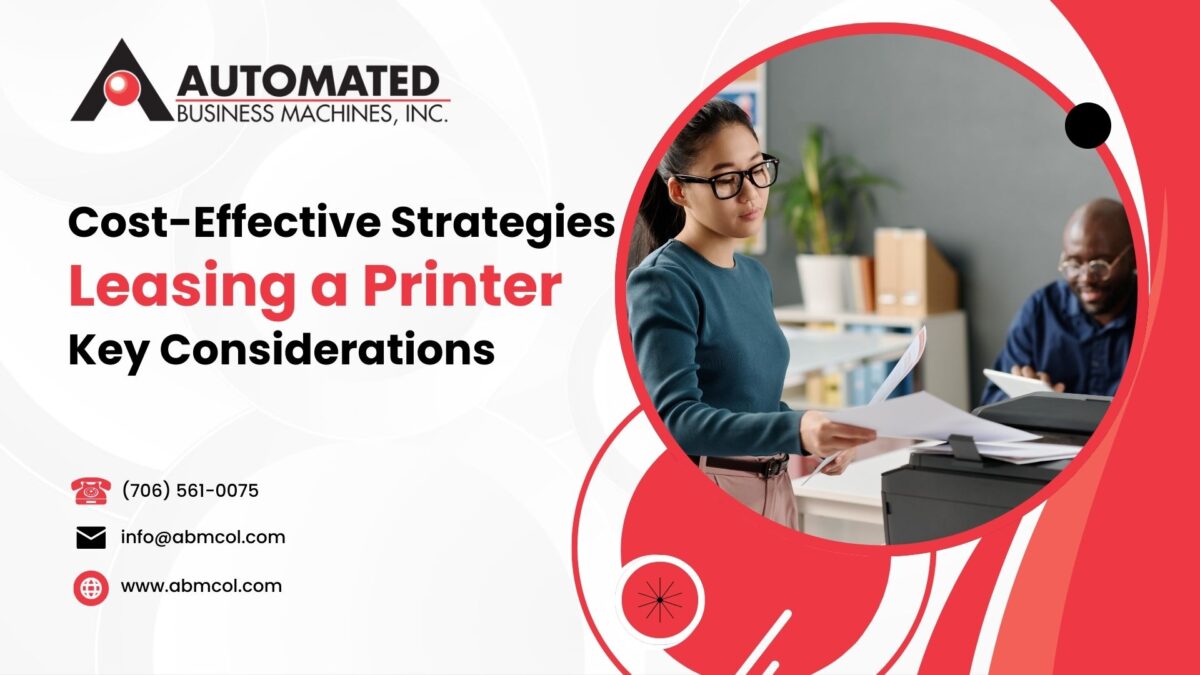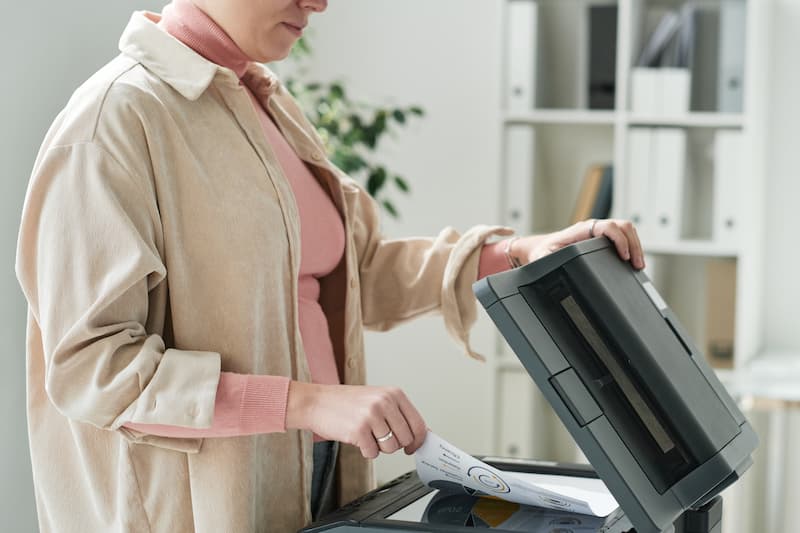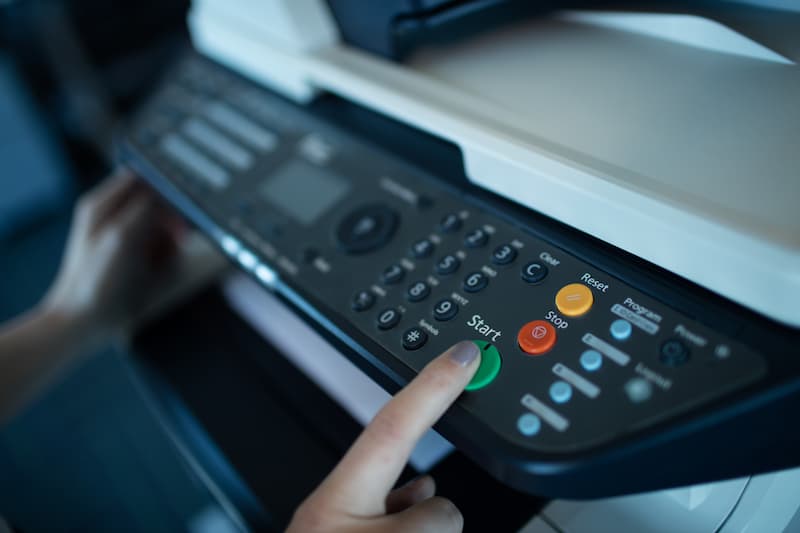
Leasing office equipment has become a popular strategy for businesses seeking cost-effective solutions. This approach allows companies to access the latest technology without the hefty upfront costs associated with purchasing. In this article, we will explore the benefits, key considerations, and practical steps involved in leasing a printer or copier, specifically tailored for small businesses looking to optimize their office operations.
Basics of Leasing a Printer and Copier

What is Leasing?
Leasing is a financial arrangement where a business rents equipment from a leasing company for a specified period. This option provides access to necessary office equipment, such as printers and copiers, without the need to purchase them outright. Unlike buying, leasing involves regular monthly payments, spreading the cost over the lease term.
Types of Printers and Copiers Available for Lease
- Multifunction Printers (MFPs): These devices combine printing, scanning, copying, and faxing capabilities into one unit, making them ideal for offices with diverse document handling needs.
- Laser Printers: Known for their high-quality prints and efficiency, laser printers are suitable for businesses with high-volume printing requirements.
- Commercial Copiers: These are designed for heavy-duty use and offer features like large paper capacities, fast printing speeds, and advanced finishing options.
Benefits of Leasing a Printer for Small Business
Cost Savings and Upfront Costs
One of the primary advantages of leasing is the significant reduction in upfront costs. Instead of paying a large sum to purchase a printer or lease a copier, businesses can distribute the expense over time with manageable monthly payments. This approach helps preserve capital and improve cash flow, which is crucial for small businesses.
Flexibility and Upgrading Equipment
Leasing provides flexibility in terms of upgrading to the latest technology. As business needs evolve, companies can easily upgrade their leased equipment to more advanced models without worrying about the depreciation of purchased assets. This adaptability ensures that businesses always have access to state-of-the-art technology, which can enhance productivity and efficiency.
Maintenance and Service Inclusions
Leasing agreements often include maintenance and service contracts, which cover routine maintenance, repairs, and technical support. This arrangement minimizes downtime and ensures that the equipment operates efficiently throughout the lease term. The leasing company handles all aspects of maintenance, allowing businesses to focus on their core operations without worrying about equipment issues.
Key Considerations in a Copier Lease Agreement
Understanding Lease Terms and Conditions

Before entering into a lease agreement, it is crucial to understand the terms and conditions. Key elements to review include the duration of the lease, early termination clauses, and the responsibilities of both parties. Knowing these details helps businesses avoid potential pitfalls and ensures a smooth leasing experience.
Monthly Lease Payments and Additional Costs
Lease agreements specify the monthly lease payments, which can vary based on the equipment type, lease term, and additional services included. It is essential to carefully review the payment schedule and be aware of any hidden fees or extra charges that may apply, such as overage fees for exceeding print volume limits or charges for consumables.
End of Lease Options
At the end of the lease term, businesses typically have several options: returning the equipment, renewing the lease, or purchasing the equipment at a predetermined price. Each option has its advantages, and the choice will depend on the company’s future needs and budget. Understanding these options in advance helps in planning and decision-making.
Comparing Leasing vs. Buying a Printer or Copier
Pros and Cons of Leasing
- Advantages: Leasing offers several benefits, including lower upfront costs, access to the latest technology, and included maintenance services. This option is particularly beneficial for small businesses that need to manage their cash flow and avoid large capital expenditures.
- Disadvantages: The total cost of leasing over time may be higher than purchasing the equipment outright. Additionally, businesses may become dependent on the leasing company for maintenance and support, which can be a disadvantage if the service quality is poor.
Pros and Cons of Buying
- Advantages: Purchasing a printer or copier outright provides ownership, which means no ongoing lease payments. This option can be more cost-effective in the long run, especially if the equipment has a long lifespan and low maintenance costs.
- Disadvantages: The initial cost of purchasing can be a significant financial burden, especially for small businesses with limited capital. Additionally, owners are responsible for all maintenance and repair costs, which can add up over time.
How to Choose the Right Leasing Company
Evaluating Leasing Companies
Selecting a reputable leasing company is crucial for a positive leasing experience. Businesses should evaluate potential leasing companies based on their reputation, customer reviews, and the range of equipment they offer. It is also beneficial to consider the company’s customer service and support capabilities, as these will be important throughout the lease term.
Questions to Ask Before Signing a Lease
- What is included in the lease agreement? Understanding what is covered by the lease, such as maintenance, repairs, and consumables, is essential.
- What are the service and maintenance terms? Ensure that the leasing company offers timely and reliable service to minimize downtime.
- Are there any additional costs? Be aware of any hidden fees or extra charges that could increase the overall cost of leasing.
Common Terms in a Copier Lease Agreement
Understanding Common Lease Terms
Lease agreements contain various terms that outline the rights and responsibilities of both parties. Important terms to understand include the lease period, renewal options, payment schedules, and penalties for early termination. Familiarity with these terms helps businesses make informed decisions and avoid unexpected costs.
Service Level Agreements (SLAs)
Service Level Agreements (SLAs) specify the leasing company’s commitment to providing maintenance and support. Key aspects of SLAs include response times, service guarantees, and equipment replacement policies. Understanding the SLA ensures that businesses receive the necessary support to keep their equipment running smoothly.
Practical Steps for Leasing a Printer or Office Copier
Assessing Your Business Needs
Before leasing a printer or copier, it is essential to assess your business needs. Consider factors such as the volume of printing and copying, the specific features and functionalities required, and the budget available for leasing. This assessment helps in selecting the right equipment that aligns with your business needs.
Calculating Total Cost of Leasing
Calculating the total cost of leasing involves considering monthly payments, additional costs, and potential tax benefits. It is also helpful to compare quotes from different leasing companies to ensure that you are getting the best deal. Taking the time to understand the total cost of leasing helps in making an informed financial decision.
Printer Leasing Process: From Application to Installation
Application and Approval Process
The leasing process begins with an application. Businesses need to provide information about their financial status, credit history, and specific equipment needs. Leasing companies use this data to assess the applicant’s creditworthiness and determine the terms of the lease. The approval process typically involves a credit check and may require additional documentation, such as financial statements or business references.
Delivery and Installation
Once the lease is approved, the leasing company arranges for the delivery and installation of the equipment. This process includes setting up the printer or copier, integrating it into the existing office infrastructure, and ensuring it is fully operational. Many leasing companies also provide initial training to staff on how to use the new equipment effectively, ensuring a smooth transition.
Managing Your Leased Office Printer
Regular Maintenance and Service
Leasing agreements often include regular maintenance services to keep the equipment in optimal condition. This includes routine inspections, cleaning, and replacing worn-out parts. Scheduling regular maintenance visits is crucial to prevent unexpected breakdowns and prolong the lifespan of the leased equipment. Leasing companies typically provide contact information for service requests, making it easy to arrange for repairs or maintenance when needed.
Tracking Usage and Performance

Monitoring the usage and performance of the leased equipment is essential to ensure it meets the business’s needs. This involves tracking print volumes, assessing the efficiency of the equipment, and identifying any recurring issues. Regularly reviewing usage patterns can help businesses adjust their operations to maximize the benefits of the leased printer or copier, such as optimizing print settings or implementing more efficient workflows.
End of Lease Considerations
Preparing for Lease Termination
As the lease term nears its end, businesses need to decide on the next steps. Options typically include returning the equipment, renewing the lease, or purchasing the equipment outright. Preparing for lease termination involves assessing the condition of the equipment, reviewing the terms of the lease agreement, and deciding which option best aligns with the company’s future needs and budget.
Renewing or Upgrading the Lease
Renewing or upgrading the lease can be an attractive option for businesses that want to continue using the latest technology without a significant upfront investment. Negotiating new lease terms or upgrading to newer models can ensure that the equipment continues to meet the business’s evolving needs. This process may involve discussions with the leasing company to adjust the lease terms and select new equipment.
What People May Also Ask
What are the tax benefits of leasing office equipment?
Leasing office equipment can offer various tax benefits, such as allowing businesses to deduct lease payments as a business expense. This can reduce the overall taxable income, resulting in tax savings. It's essential to consult with a tax professional to understand the specific tax implications for your business.
How does the cost of leasing compare to buying?
The cost of leasing is typically lower upfront compared to buying. However, the total cost over the lease term may be higher. Leasing spreads the expense over time, making it easier to manage cash flow, whereas buying involves a significant initial investment but can be more cost-effective in the long run if the equipment is used for many years.
What happens if the leased equipment breaks down?
Most leasing agreements include maintenance and service provisions, which cover repairs and technical support. If the equipment breaks down, businesses can contact the leasing company to arrange for repairs or replacement. This minimizes downtime and ensures that the equipment remains operational.
Can I upgrade my leased printer or copier before the lease ends?
Many leasing agreements allow for equipment upgrades before the lease term ends. This option is beneficial for businesses that need to stay current with the latest technology. Upgrading may involve renegotiating the lease terms and potentially adjusting the monthly payments.
What are the hidden costs associated with leasing?
Hidden costs in leasing agreements can include overage fees for exceeding print volume limits, charges for consumables like toner and paper, and penalties for early termination. It's crucial to review the lease agreement carefully and ask the leasing company about any additional costs that may apply.
Conclusion
Leasing a printer or copier offers numerous benefits, including lower upfront costs, access to the latest technology, and included maintenance services. It provides flexibility for businesses to upgrade equipment as their needs evolve and helps manage cash flow more effectively. However, understanding the terms of the lease agreement, potential hidden costs, and end-of-lease options is crucial for making an informed decision.
Leasing is a viable option for businesses seeking cost-effective solutions for their office equipment needs. By carefully evaluating leasing companies, understanding lease terms, and assessing business requirements, companies can make strategic decisions that align with their operational goals and budget constraints. Considering leasing as part of a broader strategy can enhance business efficiency and ensure access to reliable, high-quality office equipment.
